Imagine you’ve just launched a new consumer product.
You’ve sold 22,345 units to a major retailer and your product is now on the store shelves.
You’re exceptionally proud of yourself and all the hard work you’ve put in to get there.
And then you get that dreaded call, followed by an email.
Consumer complaints have triggered a recall. Your product is now deemed unsafe for the general marketplace and all units need to be returned or pulled from stores.
This is a situation no importer wants to face.
Aside from the impact on your business, there is also the stress of knowing your product might actually be causing injury to people, perhaps even children.
Quality assurance and quality control are all about mitigating risk. And in our business, the goal is to help customers minimize the likelihood of these kinds of events as much as possible.
Today we’re going to talk about 5 recent product recalls and what we can learn from them.

The CPSC website has a list of recent recalls
We’ll take a look at the information that is publicly available about each recall and discuss what happened.
Then, based on our experience, we’ll talk about the typical causes of these kinds of issues and how you can work to avoid them.
Here are 5 Product Recalls We’ve Seen Recently in the U.S. and Canada
On the U.S. CPSC (Consumer Product Safety Commission) website, they host a list of product recalls, which is updated regularly.
After reviewing some of the more recent recalls, we selected the following five to talk about. They cover a range of different issues. The information for each one comes directly from its listing.
#1 Rite Aid Recalls Folding Patio Chairs Due to Fall Hazard (link)
The chair frame can bend causing the user to fall, posing a risk of injury.
#2 Kirkland’s Recalls Chests of Drawers Due to Tip-Over and Entrapment Hazards (link)
The recalled chests are unstable if they are not anchored to the wall, posing serious tip-over and entrapment hazards that can result in death or injuries to children.
#3 RH Recalls Turkish Robes Due to Violation of Federal Flammability Standard (link)
The Turkish robes fail to meet the flammability standards for clothing textiles, posing a risk of burn injuries to consumers.
#4 RH Recalls Children’s Chairs and Stools Due to Violation of Federal Lead Paint Ban (link)
Paint on the chairs and stools contain levels of lead that exceed the federal lead paint ban. Lead is toxic if ingested by young children and can cause adverse health effects.
#5 Pearhead Recalls Ubbi Connecting Bath Toys Due To Choking Hazard (link)
The recalled toys can break and create a sharp point, posing laceration and choking hazards to young children.
What Can We Learn From These Product Recalls? 3 Important Things
It needs to be said that we do not have an inside look at any of these recalls, and can only view them from the outside.
Therefore, we don’t know the exact reasons for each issue, and can only speak from our own general experience with quality assurance and quality control.
Three key thoughts that come to mind upon reviewing these.
#1 Manufacturing Issues aren’t Always to Blame, Sometimes it Comes Down to Design Issues

Manufacturing issues are not always to blame for product recalls
If your first thought is to blame the factory for an issue like splintering bath toys or a bent folding chair, you may want to take a closer look.
Sometimes, these issues come down to your design.
The metal chairs might be bending because they aren’t designed well enough for their intended purpose.
The same could be said for the bath toys. Perhaps the designer didn’t foresee how they would respond to being dropped or thrown.
That being said, design may have not been the problem in these cases. So, how would you determine that?
You would do so by looking at the specifications.
#2 The Importance of Clear Specifications Cannot Be Understated
When communicating with your factory, instructions need to be as clear as possible.
One of the fundamental things you need to do is create a clear specification sheet for them to follow.
For example, the bent metal folding chairs could be attributed to the wrong grade of metal being used.
In the design stage, a metal grade should be chosen that is suitable for the purpose of the product and for any foreseeable uses. That metal grade needs to be specified in the document.
As long as that metal grade is included in the specification sheet, then you can determine whether or not they have used the correct metal.
If there is no particular metal specified by the importer, regardless of the performance of the chairs, the factory hasn’t technically done anything wrong.
Assuming you have a sound design and have specified everything clearly, how do you ensure that your products don’t have any incorrect materials or chemicals in them?
#3 Testing is an Important Aspect of Quality Control
Laboratory testing can play a role in avoiding issues like the Turkish robes not passing flammability standards or the lead paint being found in children’s chairs.
These types of matters are more or less black and white, and there are clear regulatory standards in place.
Sending some of your completed products from the factory to a lab will help you identify whether they have harmful chemicals in them.
With regard to the metal chairs and plastic toys, one thing to consider is incoming raw materials testing. You need to ensure that your factory is doing proper testing on the materials they receive.
Beyond that, you can consider hiring a third-party inspection company like ours to conduct Pre-Production Inspections on incoming materials, when needed.
Testing helps ensure that the right materials are going into your products and that they are free of harmful chemicals.
Having a well-rounded QA/QC program is important and you need to strike the right balance between the price of your products and their quality.
To learn more about this, we recommend reading the following white paper.
Price vs. Quality: What You Need to Know
When you’re making products to sell in the marketplace, you have to consider the tradeoffs between price and quality. Sometimes, producing better quality products can lead to paying a higher price for manufacturing.
Download our free white paper, Price vs. Quality, to learn how to produce great quality while keeping your costs low.





As a Quality A ssurance person, It is more feasible, to work with designers internally. I’ve had more success with design, production and quality management teams,introduce and discuss product line. Flag issues, Meld their ideas for a solution, then follow up with ports with corrections The reason, manufacturers, whatever the product, know their products, infrastructure, and business. Someone from the outside, will have a spec to go by some auditors are reliable, some not so much. Bottom line Fty. Is responsible for the recall. (Been there, done that) recalls are very expensive.
Thank you for your comments. The party responsible for the recall is the importer of record. For specifics on liability, recall recourse, etc one should consult with a lawyer who is versed in recalls.